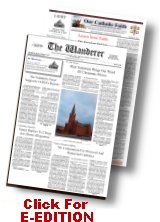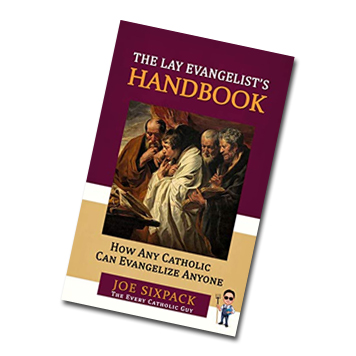The Sign Of The Cross: The Earliest Sacramental
By JAMES MONTI
The concept of making the Cross upon which Our Lord died the ultimate symbol of His entire mission of our redemption came from the lips of Our Lord Himself, for it is implicit in His command that if we are to be His true disciples, we must take up our own crosses and follow Him. St. Paul invokes the image of the Cross directly:
“But far be it for me to glory except in the cross of our Lord Jesus Christ, by which the world has been crucified to me, and I to the world” (Gal. 6:14). The expansion of the invocation of the Cross into all aspects of a Christian’s life arose quite early in the history of the Church. In his work De Corona, Tertullian (+c. 220) attests:
“At every forward step and movement, at every going in and out, when we put on our clothes and shoes, when we bathe, when we sit at table, when we light the lamps, on couch, on seat, in all the ordinary actions of daily life, we trace upon the forehead the Sign [of the Cross]” (De Corona, chapter 3, in The Ante-Nicene Fathers: Translations of the Writings of the Fathers down to A. 325: volume III, ed. Alexander Roberts and James Donaldson, Christian Literature Publishing Co., 1887, pp. 94-95).
Writing at about the same time, Origen (+c. 253) speaks of the Sign of the Cross as instilling fear and trembling in demons. In the fourth century, St. Cyril of Jerusalem gives instructions similar to those of Tertullian about the role of the Sign of the Cross in our daily lives:
“Let us, therefore, not be ashamed of the Cross of Christ; but though another hide it, do thou openly seal it upon thy forehead, that the devils may behold the royal sign and flee trembling far away. Make then this sign at eating and drinking, at sitting, at lying down, at rising up, at speaking, at walking: in a word, at every act” (Catechetical Lecture 4, n. 13, in A Select Library of the Nicene and Post-Nicene Fathers of the Christian Church, Second Series: Volume VII, ed. Philip Schaff and Henry Wace, New York, Christian Literature Co., 1894, p. 22).
The early references to making the Sign of the Cross refer mostly to making this sign on the forehead, a practice believed to have been inspired by a passage from the Book of Ezekiel:
“Now the glory of the God of Israel had gone up from the cherubim on which it rested to the threshold of the house; and he called to the man clothed in linen, who had the writing case at his side. And the Lord said to him, ‘Go through the city, through Jerusalem, and put a mark on the foreheads of the men who sigh and groan over all the abominations that are committed in it’” (Ezek. 9: 3-4).
The Book of Revelation would have also given impetus to the signing of the forehead: “Then I looked, and lo, on Mount Zion stood the Lamb, and with him a hundred and forty-four thousand who had his name and his Father’s name written on their foreheads” (Rev. 14:1).
In his book on Baptism, the Eastern bishop and ecclesiastical writer Theodore of Mopsuestia (+c. 428) explains that as “the highest and noblest part of the body” the forehead is a particularly appropriate locus for the Sign of the Cross, for it is also the part of the body to which the eyes of those we converse with are directed, and therefore if we exhibit this mark before the eyes of God, we will be given the reward of beholding Him face to face in the life to come (Liber de Baptizandos, chapter 2, cited in Brendan Lupton, “The Sign of the Cross in the Dialogues of Gregory the Great,” Downside Review, volume 138, n. 3, 2020, p. 101).
In addition to physical gestures of the Sign of the Cross, images of the Cross arose in the early Church by the fifth century and also found their way into the many different settings of a Christian’ daily life. Archaeologists exploring the ruins of the ancient abandoned city of Istros on the Black Sea coast of Romania have discovered thirty-four artifacts marked with the Sign of the Cross or fashioned in the shape of a cross, ranging from a pot and tableware to lamps and a scale.
One common thread that runs through the afore-cited early evidence for the use of the Sign of the Cross is that these crosses both in the form of gestures and as physical objects were made in plentitude. Both Tertullian and St. Cyril of Jerusalem could have chosen to say that the cross is so powerful that one Sign of the Cross upon rising at daybreak would suffice for the entire day. But instead, they enjoin the faithful to make the Cross many times a day, to sanctify every action of the day with it.
In this context we can see how the making of the Sign of the Cross over twenty times by the priest celebrating Mass while reciting the Roman Canon would have arisen quite naturally and organically. Early manuscripts of the Gregorian Sacramentary show that this practice was in place by the eighth century. Of course, in this case, the Sign of the Cross was made not on the forehead but rather with a crosswise motion of the hand over the Oblata upon the altar. It is likewise by the eighth century that we find the beginnings of the custom of tracing a cross upon oneself with a full sweep of the hand from the forehead to the sternum, and then from one shoulder to the other.
Elsewhere in the rites of the sacred liturgy, the Sign of the Cross became a widespread gesture. As a signing of the forehead, it was already a component of the baptismal rites in the third century. St. Basil the Great (+379) claimed that this practice had been handed down from the apostles. In the rites of extreme unction, the anointing of the five senses represented by five different parts of the body (eyebrows, ears, nostrils, hands, and lips) by tracing a cross with the oil of the sick had arisen by the ninth century.
By the eleventh century, the practice of signing oneself with the Cross not only on the forehead but also on the lips and over the heart had appeared as a preparation for hearing the Gospel at Mass.
From the beginning, the making of the Sign of the Cross was understood as a spiritual defense against demonic attacks. St. Anthony the Abbot had frequent recourse to the Sign of the Cross for this purpose.
The subject of the image of Cross is so vast that we can only address one further chapter of its long history here, namely, the remarkable role of the image of the Cross on the French and Belgian battlefields of World War I.
A Much-Needed Reminder
Much of the fighting during the First World War transpired across French and Belgian countryside terrain dotted with roadside crosses, largely in the form of crucifixes. Amid the horrific carnage and misery of the fighting that claimed the lives of so many soldiers, these crucifixes became a source of comfort not only to Catholic soldiers but also to those of other faiths who came to recognize a certain similitude between their own battle scars and the wounds of Christ: “Tommies [British soldiers] who may never before have seen crucifixes were attracted to the wayside calvaries they came across in France and Belgium” (K. Inglis, Foreword to Annette Becker, War and Faith: Religious Imagination in France, 1914-1930, Oxford, Berg, 1998, p. x).
These men of different faiths also noticed that in many cases these rural shrines of Calvary miraculously survived in the midst of landscapes of otherwise total devastation from the fighting.
A particularly striking example of this could be seen for many years in the cemetery of the French town of Ypres, where a wayside Calvary scene survived amid thousands of German shells that rained down during the fighting, one of which became lodged in the space between one of Christ’s outstretched arms and the wood of the cross without doing any harm to the image.
One British soldier was to fashion his own personal image of the Cross from his very close brush with death on the battlefield. In June of 1917 Rifleman Vincent Sabini was shot in the knee during fighting in Messines, Belgium. After recovering from his wound, he had the bullet extracted from his leg made into a crucifix that he wore around his neck for the rest of his life as an expression of his gratitude to God for having survived the battle.
Another British soldier named John Scollen made a little cross to send home to his wife and children with a farewell letter addressed to them just days before his death in battle in July of 1916 (Alexander Saunders, “Crucifix, Calvary, and Cross: Materiality and Spirituality in Great War Landscapes,” World Archaeology, volume 35, n. 1 [2003], pp. 14-16).
The solemnity of the Exaltation of the Holy Cross on September 14 serves as a much-needed reminder of the mystery of Good Friday and how that mystery touches every aspect of our lives. Each Sign of the Cross we make, from the Sign of the Cross we trace upon ourselves upon waking in the morning to the Sign of the Cross we make each time we pass a Catholic Church, takes us back in spirit to Golgotha and the love of God supremely revealed there.
May the Sign of the Cross protect us from every temptation and every evil until we are safely home in Heaven.










